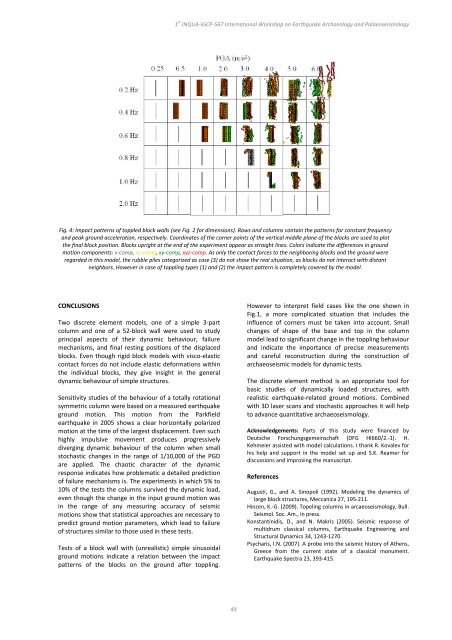Archaeoseismology and Palaeoseismology in the Alpine ... - Tierra
Archaeoseismology and Palaeoseismology in the Alpine ... - Tierra
Archaeoseismology and Palaeoseismology in the Alpine ... - Tierra
You also want an ePaper? Increase the reach of your titles
YUMPU automatically turns print PDFs into web optimized ePapers that Google loves.
1 st INQUA‐IGCP‐567 International Workshop on Earthquake Archaeology <strong>and</strong> <strong>Palaeoseismology</strong><br />
Fig. 4: Impact patterns of toppled block walls (see Fig. 2 for dimensions). Rows <strong>and</strong> columns conta<strong>in</strong> <strong>the</strong> patterns for constant frequency<br />
<strong>and</strong> peak ground acceleration, respectively. Coord<strong>in</strong>ates of <strong>the</strong> corner po<strong>in</strong>ts of <strong>the</strong> vertical middle plane of <strong>the</strong> blocks are used to plot<br />
<strong>the</strong> f<strong>in</strong>al block position. Blocks upright at <strong>the</strong> end of <strong>the</strong> experiment appear as straight l<strong>in</strong>es. Colors <strong>in</strong>dicate <strong>the</strong> differences <strong>in</strong> ground<br />
motion components: x‐comp, xz‐comp, xy‐comp, xyz‐comp. As only <strong>the</strong> contact forces to <strong>the</strong> neighbor<strong>in</strong>g blocks <strong>and</strong> <strong>the</strong> ground were<br />
regarded <strong>in</strong> this model, <strong>the</strong> rubble piles categorized as case (3) do not show <strong>the</strong> real situation, as blocks do not <strong>in</strong>teract with distant<br />
neighbors. However <strong>in</strong> case of toppl<strong>in</strong>g types (1) <strong>and</strong> (2) <strong>the</strong> impact pattern is completely covered by <strong>the</strong> model.<br />
CONCLUSIONS<br />
Two discrete element models, one of a simple 3‐part<br />
column <strong>and</strong> one of a 52‐block wall were used to study<br />
pr<strong>in</strong>cipal aspects of <strong>the</strong>ir dynamic behaviour, failure<br />
mechanisms, <strong>and</strong> f<strong>in</strong>al rest<strong>in</strong>g positions of <strong>the</strong> displaced<br />
blocks. Even though rigid block models with visco‐elastic<br />
contact forces do not <strong>in</strong>clude elastic deformations with<strong>in</strong><br />
<strong>the</strong> <strong>in</strong>dividual blocks, <strong>the</strong>y give <strong>in</strong>sight <strong>in</strong> <strong>the</strong> general<br />
dynamic behaviour of simple structures.<br />
Sensitivity studies of <strong>the</strong> behaviour of a totally rotational<br />
symmetric column were based on a measured earthquake<br />
ground motion. This motion from <strong>the</strong> Parkfield<br />
earthquake <strong>in</strong> 2005 shows a clear horizontally polarized<br />
motion at <strong>the</strong> time of <strong>the</strong> largest displacement. Even such<br />
highly impulsive movement produces progressively<br />
diverg<strong>in</strong>g dynamic behaviour of <strong>the</strong> column when small<br />
stochastic changes <strong>in</strong> <strong>the</strong> range of 1/10,000 of <strong>the</strong> PGD<br />
are applied. The chaotic character of <strong>the</strong> dynamic<br />
response <strong>in</strong>dicates how problematic a detailed prediction<br />
of failure mechanisms is. The experiments <strong>in</strong> which 5% to<br />
10% of <strong>the</strong> tests <strong>the</strong> columns survived <strong>the</strong> dynamic load,<br />
even though <strong>the</strong> change <strong>in</strong> <strong>the</strong> <strong>in</strong>put ground motion was<br />
<strong>in</strong> <strong>the</strong> range of any measur<strong>in</strong>g accuracy of seismic<br />
motions show that statistical approaches are necessary to<br />
predict ground motion parameters, which lead to failure<br />
of structures similar to those used <strong>in</strong> <strong>the</strong>se tests.<br />
Tests of a block wall with (unrealistic) simple s<strong>in</strong>usoidal<br />
ground motions <strong>in</strong>dicate a relation between <strong>the</strong> impact<br />
patterns of <strong>the</strong> blocks on <strong>the</strong> ground after toppl<strong>in</strong>g.<br />
49<br />
However to <strong>in</strong>terpret field cases like <strong>the</strong> one shown <strong>in</strong><br />
Fig.1, a more complicated situation that <strong>in</strong>cludes <strong>the</strong><br />
<strong>in</strong>fluence of corners must be taken <strong>in</strong>to account. Small<br />
changes of shape of <strong>the</strong> base <strong>and</strong> top <strong>in</strong> <strong>the</strong> column<br />
model lead to significant change <strong>in</strong> <strong>the</strong> toppl<strong>in</strong>g behaviour<br />
<strong>and</strong> <strong>in</strong>dicate <strong>the</strong> importance of precise measurements<br />
<strong>and</strong> careful reconstruction dur<strong>in</strong>g <strong>the</strong> construction of<br />
archaeoseismic models for dynamic tests.<br />
The discrete element method is an appropriate tool for<br />
basic studies of dynamically loaded structures, with<br />
realistic earthquake‐related ground motions. Comb<strong>in</strong>ed<br />
with 3D laser scans <strong>and</strong> stochastic approaches it will help<br />
to advance quantitative archaeoseismology.<br />
Acknowledgements: Parts of this study were f<strong>in</strong>anced by<br />
Deutsche Forschungsgeme<strong>in</strong>schaft (DFG HI660/2.‐1). H.<br />
Kehmeier assisted with model calculations. I thank R. Kovalev for<br />
his help <strong>and</strong> support <strong>in</strong> <strong>the</strong> model set up <strong>and</strong> S.K. Reamer for<br />
discussions <strong>and</strong> improv<strong>in</strong>g <strong>the</strong> manuscript.<br />
References<br />
Augusti, G., <strong>and</strong> A. S<strong>in</strong>opoli (1992). Model<strong>in</strong>g <strong>the</strong> dynamics of<br />
large block structures, Meccanica 27, 195‐211.<br />
H<strong>in</strong>zen, K.‐G. (2009). Topel<strong>in</strong>g columns <strong>in</strong> arcaeoseismology, Bull.<br />
Seismol. Soc. Am., <strong>in</strong> press.<br />
Konstant<strong>in</strong>idis, D., <strong>and</strong> N. Makris (2005). Seismic response of<br />
multidrum classical columns, Earthquake Eng<strong>in</strong>eer<strong>in</strong>g <strong>and</strong><br />
Structural Dynamics 34, 1243‐1270.<br />
Psycharis, I.N. (2007). A probe <strong>in</strong>to <strong>the</strong> seismic history of A<strong>the</strong>ns,<br />
Greece from <strong>the</strong> current state of a classical monument.<br />
Earthquake Spectra 23, 393‐415.



